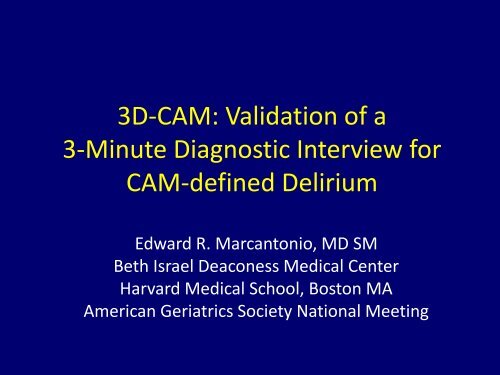3D-CAM - American Geriatrics Society
3D-CAM - American Geriatrics Society
3D-CAM - American Geriatrics Society
- No tags were found...
You also want an ePaper? Increase the reach of your titles
YUMPU automatically turns print PDFs into web optimized ePapers that Google loves.
<strong>3D</strong>-<strong>CAM</strong>: Validation of a3-Minute Diagnostic Interview for<strong>CAM</strong>-defined DeliriumEdward R. Marcantonio, MD SMBeth Israel Deaconess Medical CenterHarvard Medical School, Boston MA<strong>American</strong> <strong>Geriatrics</strong> <strong>Society</strong> National Meeting
Acknowledgements/ConflictsCo-Authors:• Long Ngo, PhD 1,3• Richard Jones, ScD 1,2,3• Kerry Palihnich 1• Margaret O’Connor, PhD 1,3• Paul Crane, MD MPH 4• Sharon Inouye, MD MPH 1,2,3• Funding:R01AG030618 fromthe National Instituteon Aging• No conflicts to report:The authors retainedfull autonomy incarrying out this workInstitutional Affiliations: 1. Beth Israel Deaconess Medical Center,2. Aging Brain Center, Institute for Aging Research, Hebrew SeniorLife,3. Harvard Medical School, 4. University of Washington
Background• Delirium: Common, Morbid, Costly– Under-recognition still a major problem• Confusion Assessment Method (<strong>CAM</strong>)*– Most widely used diagnostic algorithm (10X > DSM)– Assess 4 diagnostic features: does not specify items– Variation in assessment → variable results• Standardized interview:– <strong>CAM</strong>-ICU: non-verbal patients– No such interview for verbal patients*Inouye et. al, Ann Int Med, 1990
<strong>3D</strong>-<strong>CAM</strong> Derivation• Dataset: >4500 <strong>CAM</strong> assessments– 160 patient questions, cognitive tests, structuredobservations, 20-25 minutes to complete• Mapped items to 4 <strong>CAM</strong> diagnostic features*• Item Response Theory: most informative items†• Modeling: further reduce items, set thresholds• Final <strong>3D</strong>-<strong>CAM</strong>: 21 items• Apply <strong>3D</strong>-<strong>CAM</strong>: Sensitivity: 92%, Specificity 93%relative to 160-item assessment*Huang et. al., JAGS, 2012; †Yang et. al., BMC Res Methods, 2013
<strong>3D</strong>-<strong>CAM</strong> ContentsFeature 1: Acute change/fluctuation—3 patient questionsEx) Have you felt confused today?Feature 2: Inattention— 4 cognitive itemsEx) Tell me the days of the week backwardsFeature 3: Disorganized Thinking—3 cognitive itemsEx) Can you tell me what type of place this is?Feature 4: Altered LOC—2 Observations• 8 Addn’l Observation Items (optional)• 1 Caregiver acute change question (if needed)
Current Aims• Prospectively validate the <strong>3D</strong>-<strong>CAM</strong> relative toa gold standard clinical delirium assessment– Subset analysis: dementia, mild cognitiveimpairment (MCI)• Measure <strong>3D</strong>-<strong>CAM</strong> inter-rater reliability
Subject Recruitment• Acutely hospitalized older adults• Aged 75 years or older• General medicine service• Large teaching hospital• Exclusions:– Non-English speaking– Imminently terminal illness– No informed consent (patient or caregiver)
Gold Standard Assessment• For delirium and dementia/MCI• Patient evaluation– History– Physical/neurological exam– Cognitive testing (MOCA)• Nurse and family interviews (AD-8)• Medical record review• Performed by experienced clinicians• Final diagnoses adjudicated by panel– Assessor, Study PI, Co-I
<strong>3D</strong>-<strong>CAM</strong> Testing• Performed within 2 hours gold standard– All testing between 11 AM-2PM• Trained RA’s blinded to gold standard results• All patients: <strong>3D</strong>-<strong>CAM</strong>• Subset: second <strong>3D</strong>-<strong>CAM</strong> (blinded to first)
Analysis• Validity: first <strong>3D</strong>-<strong>CAM</strong> delirium determinationcompared to gold standard delirium diagnosis– Sensitivity, specificity– Stratified by dementia/MCI status• Reliability: two <strong>3D</strong>-<strong>CAM</strong> results compared– Kappa statistic
Study SchematicGold StandardAssessment(N=201)<strong>3D</strong>-<strong>CAM</strong> 1(N=201)<strong>3D</strong>-<strong>CAM</strong> 2(n=100)Delirium DiagnosisValidityDelirium DeterminationReliabilityDelirium Determination
Study Population (N=201)Subject CharacteristicMean ± S.D., N(%),Median [IQR]Age (years) 84±5Female Gender 125 (62%)Delirium (Gold standard) 42 (21%)Dementia/MCI (Gold standard)DementiaMCI113 (57%)54 (27%)59 (30%)Duration of <strong>3D</strong>-<strong>CAM</strong> (minutes) 3 [IQR 2,5]
DeliriumDiagnosis(- or +)Gold standard(-)Gold standard(+)<strong>3D</strong>-<strong>CAM</strong>(-)Validity<strong>3D</strong>-<strong>CAM</strong>(+)GoldStandardTotalsTestCharacteristic%, 95% C.I.150 9* 159 Specificity=150/15994% [91%,98%]2 40 42 Sensitivity=40/4295% [89%,100%]<strong>3D</strong>-<strong>CAM</strong> Totals 152 49 201*Of 9 <strong>3D</strong>-<strong>CAM</strong> “false positives”, 6 had sub-syndromal delirium
Validity: Subgroup AnalysisNormal baseline cognition• Sensitivity: 100% [87%,100%]• Specificity: 98% [94%,100%]Dementia/MCI• Sensitivity: 95% [87%,100%]• Specificity: 91% [84%,97%]
Inter-rater reliabilityDeliriumDiagnosis(- or +)<strong>3D</strong>-<strong>CAM</strong> 2(-)<strong>3D</strong>-<strong>CAM</strong> 2(+)<strong>3D</strong>-<strong>CAM</strong> 1Totals<strong>3D</strong>-<strong>CAM</strong> 1(-)<strong>3D</strong>-<strong>CAM</strong> 1(+)<strong>3D</strong>-<strong>CAM</strong> 2Totals74 1 754 21 2578 22 100Kappa Statistic=0.86 [0.74,0.98]
Methodological ConsiderationsLimitations• Cross-sectional study– Does not address repeatedadministration• Single hospital study• Medicine patients onlyStrengths• Large validation study• Challenge population– Very old– High prevalence dementia/MCI
Conclusions/Implications• <strong>3D</strong>-<strong>CAM</strong>:– Structured interview for verbal patients– Assesses 4 <strong>CAM</strong> diagnostic features– Completed 3 minutes• Excellent validity relative to gold standard– Works well in patients with dementia/MCI• Excellent inter-rater reliability• Because of brevity and ease of use, <strong>3D</strong>-<strong>CAM</strong>could be important tool for improving deliriumcare, education, and research
















